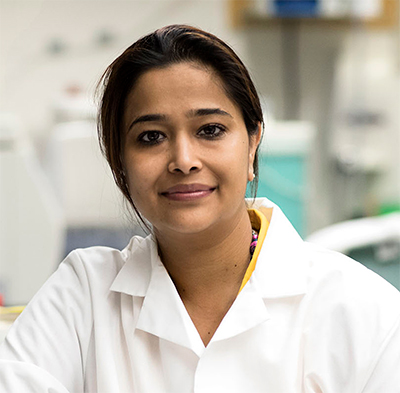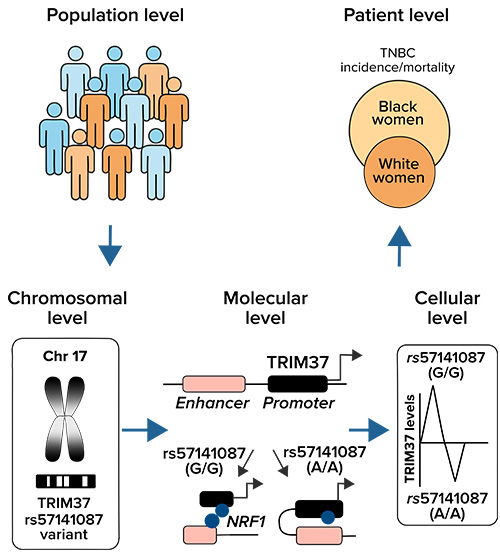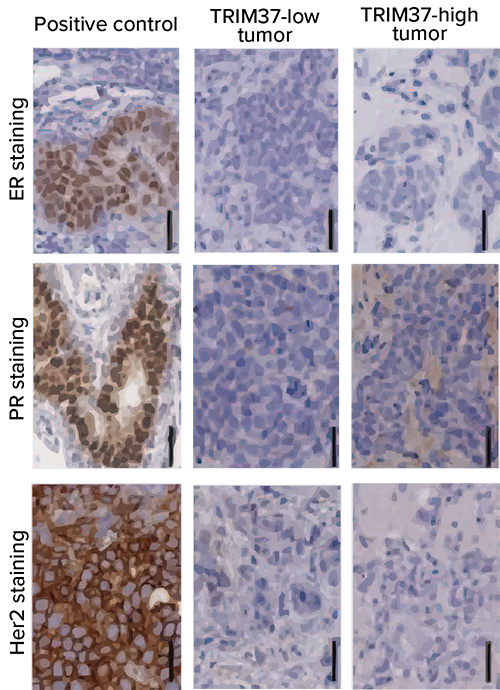
Triple-negative breast cancer (TNBC) is an aggressive breast cancer for which few treatment options are available. It is serious because it spreads quickly and has a high rate of recurrence.
Black women are twice as likely as white women to be diagnosed with TNBC. They are also more likely to die from the devastating disease. The five-year survival rate for TNBC in Black women is only 14% compared to 36% in women from other racial backgrounds.
Multiple biological and socioeconomic factors are blamed for this higher risk. UC Davis Comprehensive Cancer Center researcher Sanchita Bhatnagar and her team have been working to get to the bottom of the genetic determinants of the racial disparity in TNBC. Results from their research were published in EMBO Reports in November 2024.

Unraveling the mystery
The Bhatnagar Laboratory team has been studying a protein called TRIM37 for over 10 years, ever since Bhatnagar discovered its role as a breast cancer-causing gene. The researchers are studying the protein encoded by that gene because it is associated with poor patient survival and resistance to chemotherapy.
Bhatnagar and her research team suspect it may hold the key to Black women developing and dying of TNBC at high rates. The study’s findings could help establish TRIM37 as a predictive biomarker, which eventually could improve TNBC diagnosis and prognosis in Black women.
The hunt for the biomarker
Bhatnagar, who is an associate professor with the UC Davis Department of Medical Microbiology and Immunology, said the missing link appears to be a predictive biomarker.
“We discovered that the TRIM37 variant known as rs57141087 is predominant in Black women and modulates TRIM37 levels,” Bhatnagar said. “Specifically, TRIM37 overexpression in early stages of triple-negative breast cancer promotes neoplastic transformations [tumor inception], accelerates tumorigenesis [tumor growth] and drives cells into malignancy [spread of cancer].”
Essentially, the presence of tumors in a patient with high levels of TRIM37 protein indicates poor prognosis and overall survival, and greater likelihood of metastasis. Increased early-stage TRIM37 levels appear to give cancer cells a “head start,” accelerating the disease trajectory and compromising outcomes.

Findings reveal key variant
In this latest research, Bhatnagar’s lab showed that cancer-free breast tissue from Black women expresses a relatively high level of the protein, which predisposes them to development of aggressive disease. The rs57141087 variant might be the reason why.
The researchers’ meta-analysis of data from 319 patients revealed TRIM37 expression in early histological stage 1 TNBC tumors that was about 1.63 times higher in Black women than in white women, which was not the case for stages 2–4.
The findings showed Black women with TNBC tumors expressing high TRIM37 had a median survival rate of about 114 months (9.5 years) while white women had a median survival of about 245 months (20.4 years). Notably, no significant differences in overall survival were observed between Black women and white women who had low TRIM37-expressing TNBC tumors.
The team previously engineered a novel TRIM37 targeting approach. They implanted a TRIM37-specific, synthetic RNA-based inhibitor in living cells by means of small vesicles, tiny substance-containing capsules called nanoparticles. A patent for targeting TRIM37 using nanoparticle delivery mechanisms is pending.
Other authors:
Along with Bhatnagar, other UC Davis Comprehensive Cancer Center contributors include Laura Fejerman, Jogender Tushir-Singh, Xiaoson Huang, Hong Li and Jie Li. The lead authors include Rachisan Tihagam, a graduate student, and Song Lou, a project scientist in the Bhatnagar Lab. Piotr Przanowski, who was a member of the Bhatnagar Lab when it was located at the University of Virginia, also contributed to the research.
This project provided research opportunities to UC Davis undergraduate students Kammi Song-Yan Liu and Bon II Koo as well. Arjun Tushir Singh, a senior at Davis High School, was also involved with the study as part of a high school science program hosted by the UC Davis Department of Medical Microbiology and Immunology.




